Clopidogrel
Unit Dose Services
Unit Dose Services
HIGHLIGHTS OF PRESCRIBING INFORMATIONThese highlights do not include all the information needed to use clopidogrel bisulfate safely and effectively. See full prescribing information for clopidogrel tablets, USP. Clopidogrel Tablets, USP Initial U.S. Approval: 1997 RECENT MAJOR CHANGES(2.4)(5.1)BOXED WARNINGWARNING: DIMINISHED EFFECTIVENESS IN POOR METABOLIZERS See full prescribing information for complete boxed warning. Effectiveness of clopidogrel bisulfate depends on activation to an active metabolite by the cytochrome P450 (CYP) system, principally CYP2C19. (5.1) Poor metabolizers treated with clopidogrel bisulfate at recommended doses exhibit higher cardiovascular event rates following acute coronary syndrome (ACS) or percutaneous coronary intervention (PCI) than patients with normal CYP2C19 function. (12.5) Tests are available to identify a patient's CYP2C19 genotype and can be used as an aid in determining therapeutic strategy. (12.5) Consider alternative treatment or treatment strategies in patients identified as CYP2C19 poor metabolizers. , (2.3 5.1) INDICATIONS AND USAGE12 Acute coronary syndrome - For patients with non-ST-segment elevation ACS [unstable angina (UA)/non-ST-elevation myocardial infarction (NSTEMI)] including patients who are to be managed medically and those who are to be managed with coronary revascularization, clopidogrel tablets, USP have been shown to decrease the rate of a combined endpoint of cardiovascular death, myocardial infarction (MI), or stroke as well as the rate of a combined endpoint of cardiovascular death, MI, stroke, or refractory ischemia. (1.1) - For patients with ST-elevation myocardial infarction (STEMI), clopidogrel tablets, USP have been shown to reduce the rate of death from any cause and the rate of a combined endpoint of death, re-infarction, or stroke. The benefit for patients who undergo primary PCI is unknown. (1.1) Recent myocardial infarction (MI), recent stroke, or established peripheral arterial disease. Clopidogrel tablets, USP have been shown to reduce the combined endpoint of new ischemic stroke (fatal or not), new MI (fatal or not), and other vascular death. (1.2) DOSAGE AND ADMINISTRATION Acute coronary syndrome. (2.1) Recent MI, recent stroke, or established peripheral arterial disease: 75 mg once daily. (2.2) DOSAGE FORMS AND STRENGTHS(3)CONTRAINDICATIONS Active pathological bleeding, such as peptic ulcer or intracranial hemorrhage. (4.1) Hypersensitivity to clopidogrel or any component of the product. (4.2) WARNINGS AND PRECAUTIONS Reduced effectiveness in impaired CYP2C19 function: Avoid concomitant use with omeprazole or esomeprazole. (5.1) Bleeding: Clopidogrel bisulfate increases risk of bleeding. Discontinue 5 days prior to elective surgery. (5.2) Discontinuation of Clopidogrel Bisulfate: Premature discontinuation increases risk of cardiovascular events. (5.3) Recent transient ischemic attack or stroke: Combination use of clopidogrel bisulfate and aspirin in these patients was not shown to be more effective than clopidogrel bisulfate alone, but was shown to increase major bleeding. (5.4) Thrombotic thrombocytopenic purpura (TTP): TTP has been reported with clopidogrel bisulfate, including fatal cases. (5.5) Side Effects(6.1)To report SUSPECTED ADVERSE REACTIONS, contact Aurobindo Pharma USA, Inc. at 1-866-850-2876 or FDA at 1-800-FDA-1088 or www.fda.gov/medwatch . DRUG INTERACTIONS Nonsteroidal anti-inflammatory drugs (NSAIDs): Combination use increases risk of gastrointestinal bleeding. (7.2) Warfarin: Combination use increases risk of bleeding. (7.3) USE IN SPECIFIC POPULATIONSNursing mothers: Discontinue drug or nursing, taking into consideration importance of drug to mother. (8.3)
FULL PRESCRIBING INFORMATION: CONTENTS*
- WARNING: DIMINISHED EFFECTIVENESS IN POOR METABOLIZERS
- 1 CLOPIDOGREL INDICATIONS AND USAGE
- 2 CLOPIDOGREL DOSAGE AND ADMINISTRATION
- 3 DOSAGE FORMS AND STRENGTHS
- 4 CLOPIDOGREL CONTRAINDICATIONS
- 5 WARNINGS AND PRECAUTIONS
- 6 CLOPIDOGREL ADVERSE REACTIONS
- 7 DRUG INTERACTIONS
- 8 USE IN SPECIFIC POPULATIONS
- 10 OVERDOSAGE
- 11 CLOPIDOGREL DESCRIPTION
- 12 CLINICAL PHARMACOLOGY
- 13 NONCLINICAL TOXICOLOGY
- 14 CLINICAL STUDIES
- 17 PATIENT COUNSELING INFORMATION
- 17.6 Medication Guide
- CLOPIDOGREL (CLOPIDOGREL BISULFATE ) TABLET, FILM COATED
FULL PRESCRIBING INFORMATION
WARNING: DIMINISHED EFFECTIVENESS IN POOR METABOLIZERS
The effectiveness of clopidogrel bisulfate is dependent on its activation to an active metabolite by the cytochrome P450 (CYP) system, principally CYP2C19 . Clopidogrel bisulfate at [see ] Warnings and Precautions (5.1) recommended doses forms less of that metabolite and has a smaller effect on platelet function in patients who are CYP2C19 poor metabolizers. Poor metabolizers with acute coronary syndrome or undergoing percutaneous coronary intervention treated with clopidogrel bisulfate at recommended doses exhibit higher cardiovascular event rates than do patients with normal CYP2C19 function. Tests are available to identify a patient's CYP2C19 genotype; these tests can be used as an aid in determining therapeutic strategy . Consider alternative treatment or treatment strategies in patients identified as CYP2C19 poor metabolizers . [see ] Clinical Pharmacology (12.5) [see ] Dosage and Administration (2.3)
1 INDICATIONS AND USAGE
1.1 Acute Coronary Syndrome (ACS)
- For patients with non-ST-segment elevation ACS [unstable angina (UA)/non-ST-elevation myocardial infarction (NSTEMI)], including patients who are to be managed medically and those who are to be managed with coronary revascularization, clopidogrel tablets, USP have been shown to decrease the rate of a combined endpoint of cardiovascular death, myocardial infarction (MI), or stroke as well as the rate of a combined endpoint of cardiovascular death, MI, stroke, or refractory ischemia.
- For patients with ST-elevation myocardial infarction (STEMI), clopidogrel tablets, USP have been shown to reduce the rate of death from any cause and the rate of a combined endpoint of death, re-infarction, or stroke. The benefit for patients who undergo primary percutaneous coronary intervention is unknown.
The optimal duration of clopidogrel tablets, USP therapy in ACS is unknown.
1.2 Recent MI, Recent Stroke, or Established Peripheral Arterial Disease
For patients with a history of recent myocardial infarction (MI), recent stroke, or established peripheral arterial disease, clopidogrel tablets, USP have been shown to reduce the rate of a combined endpoint of new ischemic stroke (fatal or not), new MI (fatal or not), and other vascular death.
2 DOSAGE AND ADMINISTRATION
2.1 Acute Coronary Syndrome
[see ] Clinical Pharmacology (12.3)
- For patients with non-ST-elevation ACS (UA/NSTEMI), initiate clopidogrel tablets with a single 300 mg oral loading dose and then continue at 75 mg once daily. Initiate aspirin (75 to 325 mg once daily) and continue in combination with clopidogrel tablets . [see ] Clinical Studies (14.1)
- For patients with STEMI, the recommended dose of clopidogrel tablet is 75 mg once daily orally, administered in combination with aspirin (75 to 325 mg once daily), with or without thrombolytics. Clopidogrel tablets may be initiated with or without a loading dose . [see ] Clinical Studies (14.1)
2.2 Recent MI, Recent Stroke, or Established Peripheral Arterial Disease
[see ] Clinical Pharmacology (12.3)
2.3 CYP2C19 Poor Metabolizers
[see ] Clinical Pharmacology (12.5)
2.4 Use with Proton Pump Inhibitors (PPI)
or[see , and ] Warnings and Precautions (5.1) Drug Interactions (7.1) Clinical Pharmacology (12.3)
3 DOSAGE FORMS AND STRENGTHS
- 75 mg tablets: Pink colored, round, biconvex, beveled edge, film-coated tablets debossed with ‘E’ on one side and ‘34’ on the other side.
4 CONTRAINDICATIONS
4.1 Active Bleeding
Clopidogrel tablets are contraindicated in patients with active pathological bleeding such as peptic ulcer or intracranial hemorrhage.
4.2 Hypersensitivity
Clopidogrel tablets are contraindicated in patients with hypersensitivity (e.g., anaphylaxis) to clopidogrel or any component of the product . [see ] Adverse Reactions (6.2)
5 WARNINGS AND PRECAUTIONS
5.1 Diminished Antiplatelet Activity Due to Impaired CYP2C19 Function
is[see ] Boxed Warning
Proton Pump Inhibitors
of[see and ]. Drug Interactions (7.1) Dosage and Administration (2.4)
5.2 General Risk of Bleeding
5.3 Discontinuation of Clopidogrel Bisulfate
5.4 Patients with Recent Transient Ischemic Attack (TIA) or Stroke
5.5 Thrombotic Thrombocytopenic Purpura (TTP)
[see ]. Adverse Reactions (6.2)
6 ADVERSE REACTIONS
- Bleeding [see ] Warnings and Precautions (5.2)
- Thrombotic thrombocytopenic purpura [see ] Warnings and Precautions (5.5)
6.1 Clinical Studies Experience
Bleeding
CURE
| Event | Clopidogrel Bisulfate (+ aspirin)* (n=6259)
|
Placebo (+ aspirin)* (n=6303)
|
|---|---|---|
| * Other standard therapies were used as appropriate. Life-threatening and other major bleeding. Major bleeding event rate for clopidogrel bisulfate + aspirin was dose-dependent on aspirin: <100 mg = 2.6%; 100 to 200 mg = 3.5%; >200 mg = 4.9%. Major bleeding event rates for clopidogrel bisulfate + aspirin by age were: <65 years = 2.5%, ≥65 to <75 years = 4.1%, ≥75 years = 5.9%. Major bleeding event rate for placebo + aspirin was dose-dependent on aspirin: <100 mg = 2%; 100 to 200 mg = 2.3%; >200 mg = 4%. Major bleeding event rates for placebo + aspirin by age were: <65 years = 2.1%, ≥65 to <75 years = 3.1%, ≥75 years = 3.6%. Led to interruption of study medication.
† ‡ § ¶ |
||
| Major bleeding
†
|
3.7
‡
|
2.7
§
|
| Life-threatening bleeding
|
2.2
|
1.8
|
| Fatal
|
0.2
|
0.2
|
| 5 g/dL hemoglobin drop
|
0.9
|
0.9
|
| Requiring surgical intervention
|
0.7
|
0.7
|
| Hemorrhagic strokes
|
0.1
|
0.1
|
| Requiring inotropes
|
0.5
|
0.5
|
| Requiring transfusion (≥4 units)
|
1.2
|
1
|
| Other major bleeding
|
1.6
|
1
|
| Significantly disabling
|
0.4
|
0.3
|
| Intraocular bleeding with significant loss of vision
|
0.05
|
0.03
|
| Requiring 2 to 3 units of blood
|
1.3
|
0.9
|
| Minor bleeding
¶
|
5.1
|
2.4
|
COMMIT
| Type of bleeding | Clopidogrel Bisulfate (+ aspirin) (n=22961)
|
Placebo (+ aspirin) (n=22891)
|
p-value |
|---|---|---|---|
| * Major bleeds were cerebral bleeds or non-cerebral bleeds thought to have caused death or that required transfusion. ** The relative rate of major noncerebral or cerebral bleeding was independent of age. Event rates for clopidogrel bisulfate + aspirin by age were: <60 years = 0.3%, ≥60 to <70 years = 0.7%, ≥70 years = 0.8%. Event rates for placebo + aspirin by age were: <60 years = 0.4%, ≥60 to <70 years = 0.6%, ≥70 years = 0.7%.
|
|||
| Major* noncerebral or cerebral bleeding**
|
0.6
|
0.5
|
0.59
|
| Major noncerebral
|
0.4
|
0.3
|
0.48
|
| Fatal
|
0.2
|
0.2
|
0.9
|
| Hemorrhagic stroke
|
0.2
|
0.2
|
0.91
|
| Fatal
|
0.2
|
0.2
|
0.81
|
| Other noncerebral bleeding (non-major)
|
3.6
|
3.1
|
0.005
|
| Any noncerebral bleeding
|
3.9
|
3.4
|
0.004
|
Other Adverse Events
6.2 Postmarketing Experience
- Agranulocytosis, aplastic anemia/pancytopenia, thrombotic thrombocytopenic purpura (TTP) Blood and lymphatic system disorders:
- : Eye (conjunctival, ocular, retinal) bleeding Eye disorders
- Gastrointestinal and retroperitoneal hemorrhage with fatal outcome, colitis (including ulcerative or lymphocytic colitis), pancreatitis, stomatitis, gastric/duodenal ulcer, diarrhea Gastrointestinal disorders:
- Fever, hemorrhage of operative wound General disorders and administration site condition:
- Acute liver failure, hepatitis (non-infectious), abnormal liver function test Hepatobiliary disorders:
- Hypersensitivity reactions, anaphylactoid reactions, serum sickness Immune system disorders:
- Musculoskeletal bleeding, myalgia, arthralgia, arthritis Musculoskeletal, connective tissue and bone disorders:
- Taste disorders, fatal intracranial bleeding, headache Nervous system disorders:
- Confusion, hallucinations Psychiatric disorders:
- Bronchospasm, interstitial pneumonitis, respiratory tract bleeding Respiratory, thoracic and mediastinal disorders:
- Increased creatinine levels Renal and urinary disorders:
- Maculopapular or erythematous rash, urticaria, bullous dermatitis, eczema, toxic epidermal necrolysis, Stevens-Johnson syndrome, angioedema, erythema multiforme, skin bleeding, lichen planus, generalized pruritus Skin and subcutaneous tissue disorders:
- Vasculitis, hypotension Vascular disorders:
7 DRUG INTERACTIONS
7.1 CYP2C19 Inhibitors
[see and ] Warnings and Precautions (5.1) Dosage and Administration (2.4)
Proton Pump Inhibitors (PPI)
[see , and Dosage and Administration (2.4) Warnings and Precautions (5.1) Clinical Pharmacology (12.3) ].
7.2 Nonsteroidal Anti-Inflammatory Drugs (NSAIDs)
7.3 Warfarin (CYP2C9 Substrates)
in vitr
8 USE IN SPECIFIC POPULATIONS
8.1 Pregnancy
Pregnancy Category B
2
8.3 Nursing Mothers
8.4 Pediatric Use
and
a
8.5 Geriatric Use
[see ] Adverse Reactions (6.1)
8.6 Renal Impairment
[see ]. Clinical Pharmacology (12.2)
8.7 Hepatic Impairment
[see ] Clinical Pharmacology (12.2)
10 OVERDOSAGE
11 DESCRIPTION
12SH1616224

12 CLINICAL PHARMACOLOGY
12.1 Mechanism of Action
12
12.2 Pharmacodynamics
12
Geriatric Patients
Renally-Impaired Patients
Hepatically-Impaired Patients
Gender
12.3 Pharmacokinetics
Absorption
Effect of Food
0-24max
Metabolism
maxmaxmax
Elimination
14Drug Interactions
Proton Pump Inhibitors (PPI)
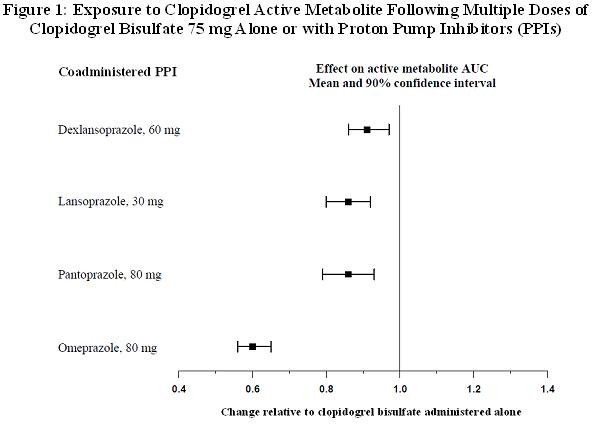
Pharmacodynamic and pharmacokinetic parameters measured in these studies showed that the interaction was highest with omeprazole and least with dexlansoprazole.
12.5 Pharmacogenomics
ex vivo
| Dose | Ultrarapid (n=10)
|
Extensive (n=10)
|
Intermediate (n=10)
|
Poor (n=10)
|
|
|---|---|---|---|---|---|
| Values are mean (SD) * Inhibition of platelet aggregation with 5 mcM ADP; larger value indicates greater platelet inhibition. Vasodilator-stimulated phosphoprotein – platelet reactivity index; smaller value indicates greater platelet inhibition.
† |
|||||
| C (ng/mL)
max
|
300 mg (24 h)
|
24 (10)
|
32 (21)
|
23 (11)
|
11 (4)
|
| 600 mg (24 h)
|
36 (13)
|
44 (27)
|
39 (23)
|
17 (6)
|
|
| 75 mg (Day 5)
|
12 (6)
|
13 (7)
|
12 (5)
|
4 (1)
|
|
| 150 mg (Day 5)
|
16 (9)
|
19 (5)
|
18 (7)
|
7 (2)
|
|
| IPA (%)*
|
300 mg (24 h)
|
40 (21)
|
39 (28)
|
37 (21)
|
24 (26)
|
| 600 mg (24 h)
|
51 (28)
|
49 (23)
|
56 (22)
|
32 (25)
|
|
| 75 mg (Day 5)
|
56 (13)
|
58 (19)
|
60 (18)
|
37 (23)
|
|
| 150 mg (Day 5)
|
68 (18)
|
73 (9)
|
74 (14)
|
61 (14)
|
|
| VASP-PRI (%)
†
|
300 mg (24 h)
|
73 (12)
|
68 (16)
|
78 (12)
|
91 (12)
|
| 600 mg (24 h)
|
51 (20)
|
48 (20)
|
56 (26)
|
85 (14)
|
|
| 75 mg (Day 5)
|
40 (9)
|
39 (14)
|
50 (16)
|
83 (13)
|
|
| 150 mg (Day 5)
|
20 (10)
|
24 (10)
|
29 (11)
|
61 (18)
|
|
13 NONCLINICAL TOXICOLOGY
13.1 Carcinogenesis, Mutagenesis, Impairment of Fertility
in vitroin vivo
2
14 CLINICAL STUDIES
14.1 Acute Coronary Syndrome
CURE
| Outcome | Clopidogrel Bisulfate (+ aspirin)* (n=6259)
|
Placebo (+ aspirin)* (n=6303)
|
Relative Risk Reduction (%) (95% CI)
|
|---|---|---|---|
| * Other standard therapies were used as appropriate. The individual components do not represent a breakdown of the primary and co-primary outcomes, but rather the total number of subjects experiencing an event during the course of the study.
† |
|||
| Primary outcome (Cardiovascular death, MI, stroke)
|
582 (9.3%)
|
719 (11.4%)
|
20% (10.3, 27.9) p < 0.001
|
| All Individual Outcome Events:
†
|
|||
| CV death
|
318 (5.1%)
|
345 (5.5%)
|
7% (-7.7, 20.6)
|
| MI
|
324 (5.2%)
|
419 (6.6%)
|
23% (11, 33.4)
|
| Stroke
|
75 (1.2%)
|
87 (1.4%)
|
14% (-17.7, 36.6)
|

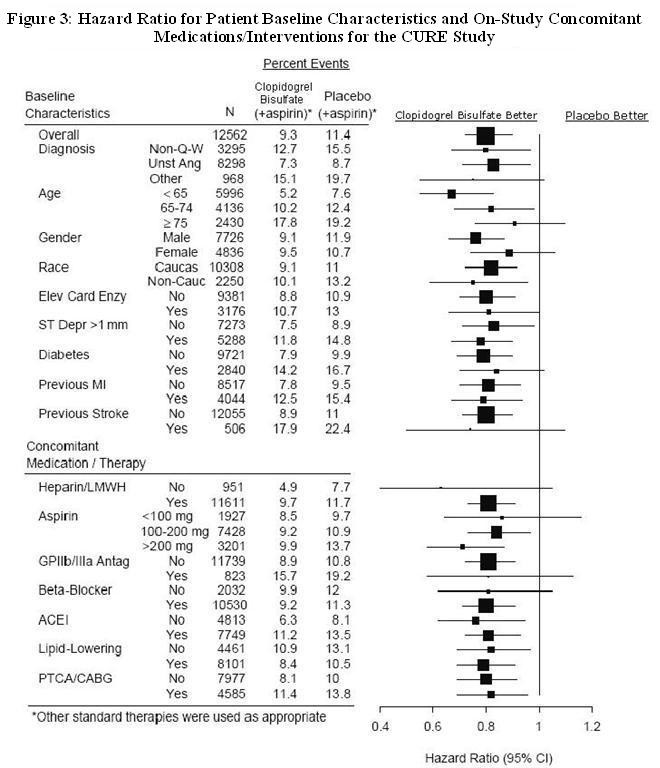
COMMIT
i.e.
| Event | Clopidogrel Bisulfate (+ aspirin) (N=22961)
|
Placebo (+ aspirin) (N=22891)
|
Odds ratio (95% CI)
|
p-value |
|---|---|---|---|---|
| * The difference between the composite endpoint and the sum of death+non-fatal MI+non-fatal stroke indicates that 9 patients (2 clopidogrel and 7 placebo) suffered both a non-fatal stroke and a non-fatal MI. ** Non-fatal MI and non-fatal stroke exclude patients who died (of any cause).
|
||||
|
Composite endpoint: Death,
MI, or Stroke* |
2121 (9.2%)
|
2310 (10.1%)
|
0.91 (0.86, 0.97)
|
0.002
|
| Non-fatal MI** Non-fatal Stroke**
Death
|
1726 (7.5%) 270 (1.2%) 127 (0.6%)
|
1845 (8.1%) 330 (1.4%) 142 (0.6%)
|
0.93 (0.87, 0.99) 0.81 (0.69, 0.95) 0.89 (0.7, 1.13)
|
0.029 0.011 0.33
|
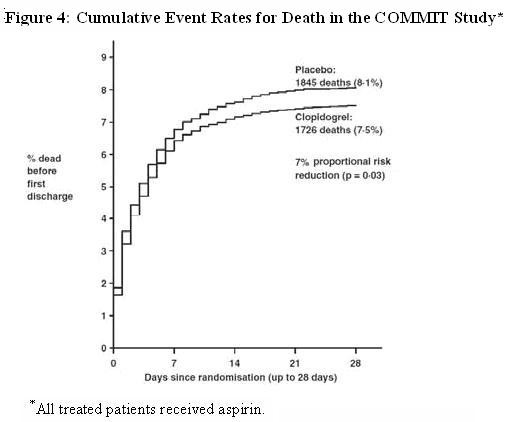

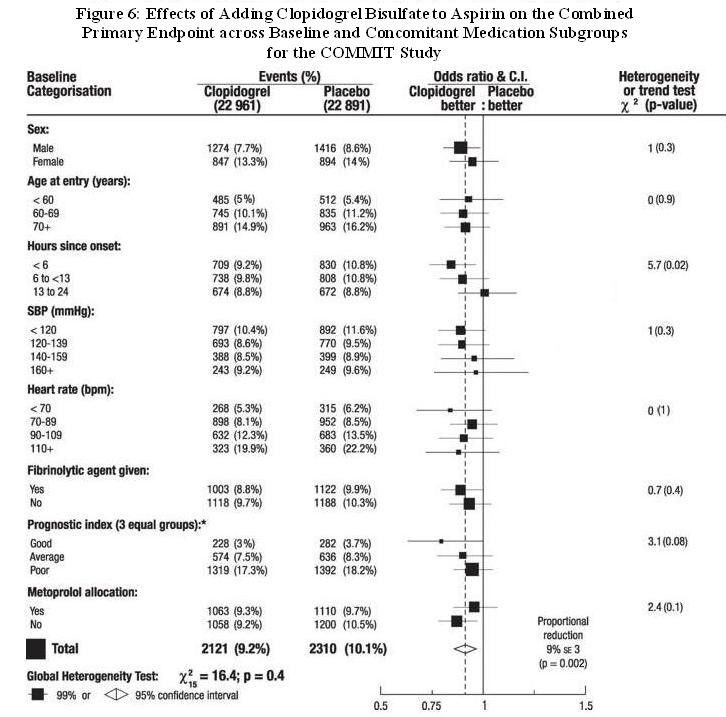
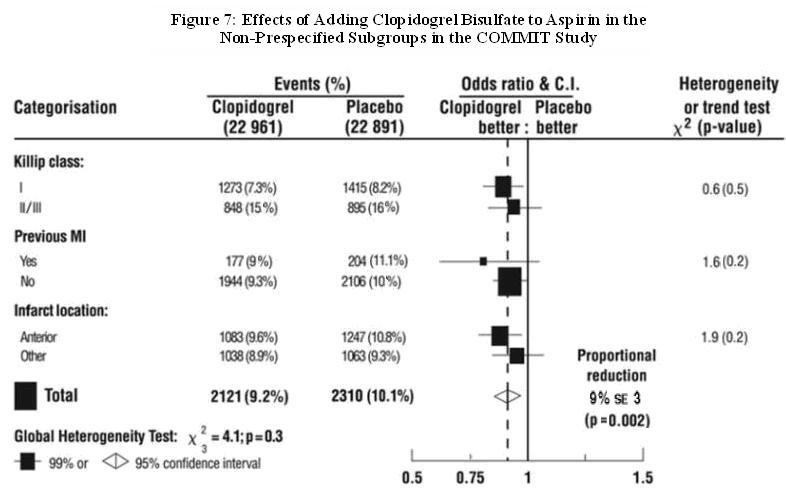
14.2 Recent Myocardial Infarction, Recent Stroke, or Established Peripheral Arterial Disease
CAPRIE
| Patients | Clopidogrel Bisulfate n=9599
|
Aspirin n=9586
|
|---|---|---|
| Ischemic stroke (fatal or not)
|
438 (4.6%)
|
461 (4.8%)
|
| MI (fatal or not)
|
275 (2.9%)
|
333 (3.5%)
|
| Other vascular death
|
226 (2.4%)
|
226 (2.4%)
|
| Total
|
939 (9.8%)
|
1020 (10.6%)
|
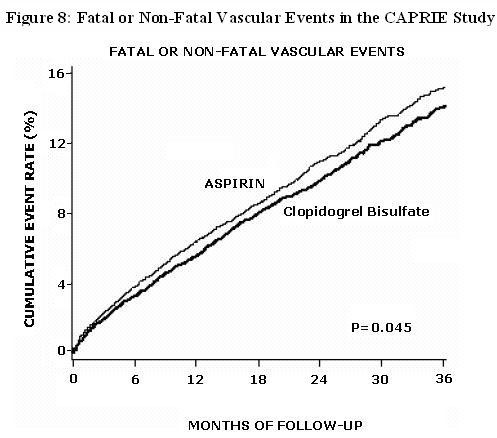
14.3 Lack of Established Benefit of Clopidogrel Bisulfate plus Aspirin in Patients with Multiple Risk Factors or Established Vascular Disease
CHARISMA
17 PATIENT COUNSELING INFORMATION
[See ] Medication Guide (17.6)
17.1 Benefits and Risks
- Summarize the effectiveness features and potential side effects of clopidogrel bisulfate.
- Tell patients to take clopidogrel bisulfate exactly as prescribed.
- Remind patients not to discontinue clopidogrel bisulfate without first discussing it with the physician who prescribed clopidogrel bisulfate.
17.2 Bleeding
- will bruise and bleed more easily.
- will take longer than usual to stop bleeding.
- should report any unanticipated, prolonged, or excessive bleeding, or blood in their stool or urine.
17.3 Other Signs and Symptoms Requiring Medical Attention
- Inform patients that TTP is a rare but serious condition that has been reported with clopidogrel bisulfate and other drugs in this class of drugs.
- Instruct patients to get prompt medical attention if they experience any of the following symptoms that cannot otherwise be explained: fever, weakness, extreme skin paleness, purple skin patches, yellowing of the skin or eyes, or neurological changes.
17.4 Invasive Procedures
- inform physicians and dentists that they are taking clopidogrel bisulfate before any invasive procedure is scheduled.
- tell the doctor performing the invasive procedure to talk to the prescribing health care professional before stopping clopidogrel bisulfate.
17.5 Concomitant Medications
[see ] Warnings and Precautions (5)
17.6 Medication Guide
Medication Guide
Clopidogrel Tablets, USP
What is the most important information I should know about clopidogrel tablets?
1. Clopidogrel tabletsmay not work as well in people who:
- Your doctor may do genetic tests to make sure clopidogrel tablets are right for you. have certain genetic factors that affect how the body breaks down clopidogrel tablets.
- Your doctor may change the medicine you take for stomach acid problems while you take clopidogrel tablets.
take certain medicines, especially omeprazole (Prilosec ) or esomeprazole (Nexium ).
®
®
2. Clopidogrel tabletscan cause bleeding which can be serious and can sometimes lead to death.
- you may bruise and bleed more easily
- you are more likely to have nose bleeds
- it will take longer for any bleeding to stop
- unexpected bleeding or bleeding that lasts a long time
- blood in your urine (pink, red or brown urine)
- red or black stools (looks like tar)
- bruises that happen without a known cause or get larger
- cough up blood or blood clots
- vomit blood or your vomit looks like coffee grounds
What are clopidogrel tablets?
- chest pain due to heart problems
- poor circulation in their legs (peripheral arterial disease)
- a heart attack
- a stroke
Who should not take clopidogrel tablets?
- currently have a condition that causes bleeding, such as a stomach ulcer
- are allergic to clopidogrel or other ingredients in clopidogrel tablets. See the end of this leaflet for a complete list of ingredients in clopidogrel tablets.
- have a history of bowel (gastrointestinal) or stomach ulcers
- have a history of bleeding problems
- plan to have surgery or a dental procedure. See ” “How should I take clopidogrel tablets?
- are pregnant or plan to become pregnant. It is not known if clopidogrel tablets will harm your unborn baby
- are breastfeeding or plan to breastfeed. It is not known if clopidogrel bisulfate passes into your breast milk. You and your doctor should decide if you will take clopidogrel tablets or breastfeed. You should not do both without talking to your doctor.
Tell your doctor about all the medicines you take,
“What is the most important information I should know about clopidogrel tablets?”
Especially tell your doctor if you take:
- aspirin, especially if you have had a stroke. Always talk to your doctor about whether you should take aspirin along with clopidogrel tablets to treat your condition.
- Non-steroidal anti-inflammatory drugs (NSAIDs). Ask your doctor or pharmacist for a list of NSAID medicines if you are not sure.
- warfarin (Coumadin , Jantoven ) ® ®
How should I take clopidogrel tablets?
- Take clopidogrel tablets exactly as your doctor tells you.
- Do not change your dose or stop taking clopidogrel tablets without talking to your doctor first. Stopping clopidogrel tablets may increase your risk of heart attack or stroke.
- Take clopidogrel tablets with aspirin as instructed by your doctor.
- You can take clopidogrel tablets with or without food.
- If you miss a dose, take clopidogrel tablets as soon as you remember. If it is almost time for your next dose, skip the missed dose. Take the next dose at your regular time. Do not take 2 doses of clopidogrel tablets at the same time unless your doctor tells you to.
- If you take too much clopidogrel bisulfate, call your doctor or go to the nearest emergency room right away.
- Talk with your doctor about stopping your clopidogrel tablets before you have surgery. Your doctor may tell you to stop taking clopidogrel tablets at least 5 days before you have surgery to avoid excessive bleeding during surgery.
Clopidogrel tabletscan cause serious side effects including:
- See “What is the most important information I should know about clopidogrel tablets?”
- TTP can happen with clopidogrel tablets, sometimes after a short time (less than 2 weeks). TTP is a blood clotting problem where blood clots form in blood vessels; and can happen anywhere in the body. TTP needs to be treated in a hospital right away, because it may cause death. Get medical help right away if you have any of these symptoms and they can not be explained by another medical condition:
A blood clotting problem called Thrombotic Thrombocytopenic Purpura (TTP).
- purplish spots (called purpura) on the skin or in the mouth (mucous membranes) due to bleeding under the skin
- your skin or the whites of your eyes are yellow (jaundice)
- you feel tired or weak
- your skin looks very pale
- fever
- fast heart rate or feeling short of breath
- headache
- speech changes
- confusion
- coma
- stroke
- seizure
- low amount of urine, or urine that is pink or has blood in it
- stomach area (abdominal) pain
- nausea, vomiting, or diarrhea
- vision changes
How should I store clopidogrel tablets?
- Store clopidogrel tablets at 20° to 25°C (68° to 77°F); excursions permitted to 15° to 30°C (59° to 86°F).
Keep clopidogrel tabletsand all medicines out of the reach of children.
General information about clopidogrel tablets
What are the ingredients in clopidogrel tablets?
Active ingredient:Inactive ingredients:
This Medication Guide has been approved by the U.S. Food and Drug Administration.
®
®®
®
Aurobindo Pharma USA, Inc.
Aurobindo Pharma Limited
CLOPIDOGREL (CLOPIDOGREL BISULFATE ) TABLET, FILM COATED

ClopidogrelClopidogrel Bisulfate TABLET, FILM COATED
| ||||||||||||||||||||||||||||||||||||||||||||||||||||||||||||||||||||||||||||||||||||||||